2011.5 PEUGEOT 3008 dashboard
[x] Cancel search: dashboardPage 34 of 328
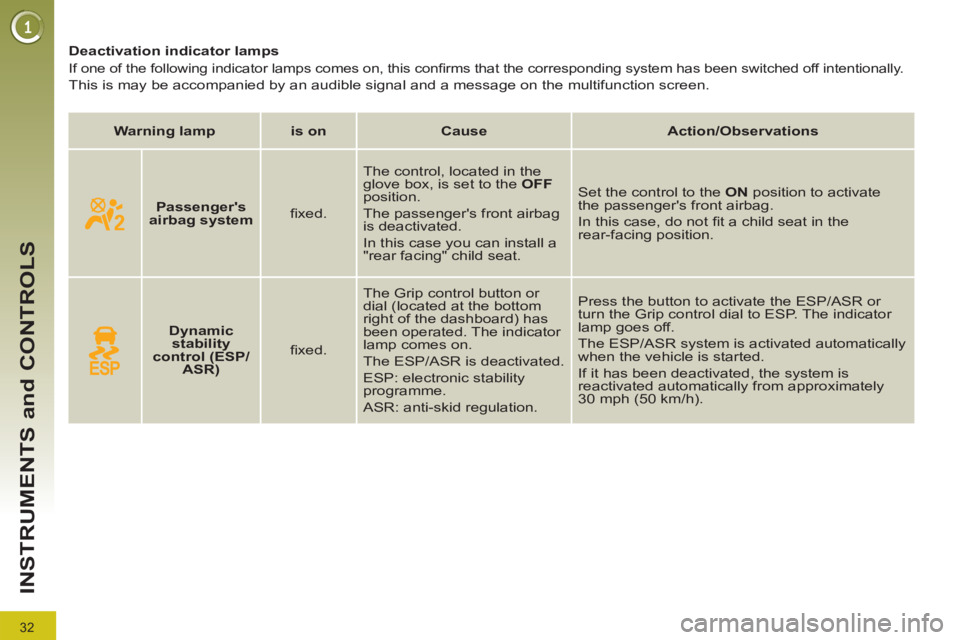
32
INSTRUMENTS and CONTROLS
Deactivation indicator lamps
If one of the following indicator lamps comes on, this confi rms that the corresponding system has been switched off intentionally.
This is may be accompanied by an audible signal and a message on the multifunction screen.
Warning lamp
is on
Cause
Action/Observations
Passenger's
airbag system
fi xed. The control, located in the
glove box, is set to the OFF
position.
The passenger's front airbag
is deactivated.
In this case you can install a
"rear facing" child seat. Set the control to the ON
position to activate
the passenger's front airbag.
In this case, do not fi t a child seat in the
rear-facing position.
Dynamic
stability
control (ESP/
ASR)
fi xed. The Grip control button or
dial (located at the bottom
right of the dashboard) has
been operated. The indicator
lamp comes on.
The ESP/ASR is deactivated.
ESP: electronic stability
programme.
ASR: anti-skid regulation. Press the button to activate the ESP/ASR or
turn the Grip control dial to ESP. The indicator
lamp goes off.
The ESP/ASR system is activated automatically
when the vehicle is started.
If it has been deactivated, the system is
reactivated automatically from approximately
30 mph (50 km/h).
Page 61 of 328

59
COMFORT
Recommendations for ventilation and air conditioning
In order for these systems to be fully effective, follow the operation and mainte-
nance guidelines below:
�)
If the interior temperature remains very high after the vehicle has been
parked in the sun for a considerable time, fi rst ventilate the passenger
compartment for a few minutes.
Place the air fl ow control at a suffi cient level to provide an adequate renewal
of air in the passenger compartment.
�)
To obtain an even air distribution, take care not to obstruct the exterior air
intake grilles located at the base of the windscreen, the nozzles, the vents
and the air outlets, as well as the air extractor located in the boot.
�)
Use in preference the intake of exterior air as prolonged use of the air recir-
culation may cause misting of the windows and side windows.
�)
Do not cover the sunshine sensor, located on the dashboard; this is used for
regulation of the automatic air conditioning system.
�)
Operate the air conditioning system for 5 to 10 minutes, once or twice a
month to keep it in good working order.
�)
Ensure that the passenger compartment fi lter is in good condition and have
the fi lter elements replaced regularly (refer to the "Checks" section).
We recommend the use of a combined passenger compartment fi lter. Thanks
to its second special active fi lter, it contributes to the purifi cation of the air
breathed by the occupants and the cleanliness of the passenger compart-
ment (reduction of allergic symptoms, bad odours and greasy deposits).
�)
The air conditioning uses power from the engine while operating. This
results in an increase in the vehicle's fuel consumption.
When towing at or near maximum capacity or on steep slopes in high ambi-
ent temperatures, switching off the air conditioning saves engine power and
so improves towing capacity.
Condensation created by the air conditioning results in a discharge of water
under the vehicle when stationary, which is perfectly normal.
�)
To ensure correct operation of the air conditioning system, you are also
advised to have it checked regularly.
�)
If the system does not produce cold air, do not use it and contact a PEUGEOT
dealer or a qualifi ed workshop.
The air conditioning system
does not contain chlorine and
does not present any danger
to the ozone layer.
Page 135 of 328
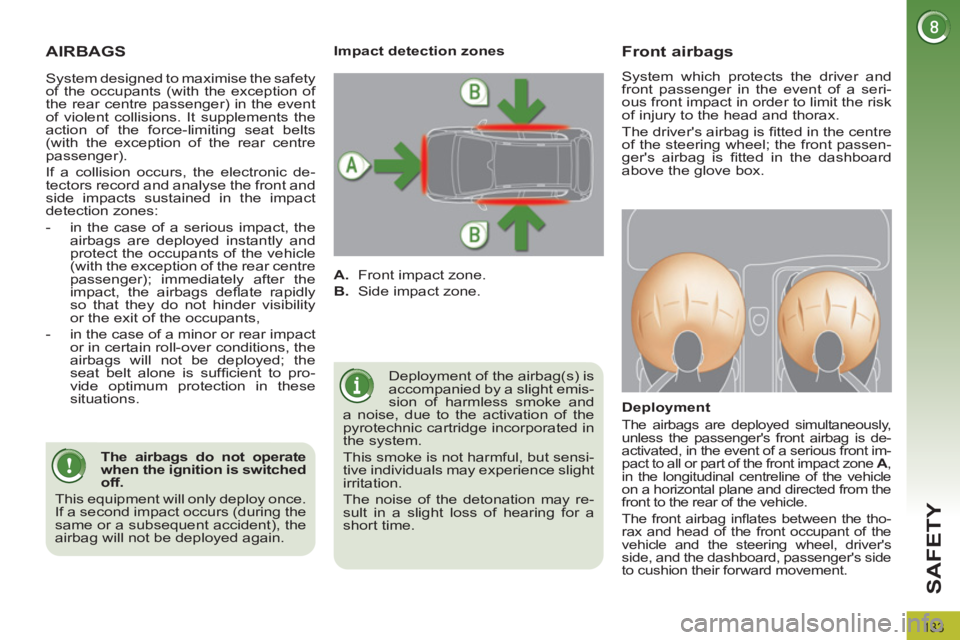
133
SAFETY
AIRBAGS
Deployment of the airbag(s) is
accompanied by a slight emis-
sion of harmless smoke and
a noise, due to the activation of the
pyrotechnic cartridge incorporated in
the system.
This smoke is not harmful, but sensi-
tive individuals may experience slight
irritation.
The noise of the detonation may re-
sult in a slight loss of hearing for a
short time.
Front airbags
System which protects the driver and
front passenger in the event of a seri-
ous front impact in order to limit the risk
of injury to the head and thorax.
The driver's airbag is fi tted in the centre
of the steering wheel; the front passen-
ger's airbag is fi tted in the dashboard
above the glove box.
Deployment
The airbags are deployed simultaneously,
unless the passenger's front airbag is de-
activated, in the event of a serious front im-
pact to all or part of the front impact zone A
,
in the longitudinal centreline of the vehicle
on a horizontal plane and directed from the
front to the rear of the vehicle.
The front airbag infl ates between the tho-
rax and head of the front occupant of the
vehicle and the steering wheel, driver's
side, and the dashboard, passenger's side
to cushion their forward movement.
Impact detection zones
A.
Front impact zone.
B.
Side impact zone.
The airbags do not operate
when the ignition is switched
off.
This equipment will only deploy once.
If a second impact occurs (during the
same or a subsequent accident), the
airbag will not be deployed again.
System designed to maximise the safety
of the occupants (with the exception of
the rear centre passenger) in the event
of violent collisions. It supplements the
action of the force-limiting seat belts
(with the exception of the rear centre
passenger).
If a collision occurs, the electronic de-
tectors record and analyse the front and
side impacts sustained in the impact
detection zones:
- in the case of a serious impact, the
airbags are deployed instantly and
protect the occupants of the vehicle
(with the exception of the rear centre
passenger); immediately after the
impact, the airbags defl ate rapidly
so that they do not hinder visibility
or the exit of the occupants,
- in the case of a minor or rear impact
or in certain roll-over conditions, the
airbags will not be deployed; the
seat belt alone is suffi cient to pro-
vide optimum protection in these
situations.
Page 138 of 328
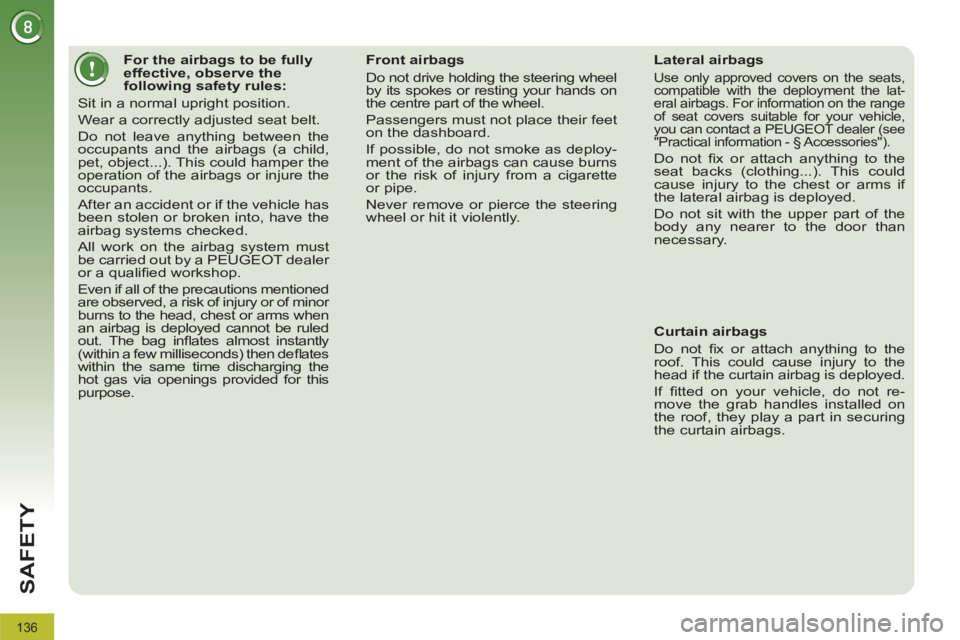
136
SAFETY
For the airbags to be fully
effective, observe the
following safety rules:
Sit in a normal upright position.
Wear a correctly adjusted seat belt.
Do not leave anything between the
occupants and the airbags (a child,
pet, object...). This could hamper the
operation of the airbags or injure the
occupants.
After an accident or if the vehicle has
been stolen or broken into, have the
airbag systems checked.
All work on the airbag system must
be carried out by a PEUGEOT dealer
or a qualifi ed workshop.
Even if all of the precautions mentioned
are observed, a risk of injury or of minor
burns to the head, chest or arms when
an airbag is deployed cannot be ruled
out. The bag infl ates almost instantly
(within a few milliseconds) then defl ates
within the same time discharging the
hot gas via openings provided for this
purpose.
Front airbags
Do not drive holding the steering wheel
by its spokes or resting your hands on
the centre part of the wheel.
Passengers must not place their feet
on the dashboard.
If possible, do not smoke as deploy-
ment of the airbags can cause burns
or the risk of injury from a cigarette
or pipe.
Never remove or pierce the steering
wheel or hit it violently.
Lateral airbags
Use only approved covers on the seats,
compatible with the deployment the lat-
eral airbags. For information on the range
of seat covers suitable for your vehicle,
you can contact a PEUGEOT dealer (see
"Practical information - § Accessories").
Do not fi x or attach anything to the
seat backs (clothing...). This could
cause injury to the chest or arms if
the lateral airbag is deployed.
Do not sit with the upper part of the
body any nearer to the door than
necessary.
Curtain airbags
Do not fi x or attach anything to the
roof. This could cause injury to the
head if the curtain airbag is deployed.
If fi tted on your vehicle, do not re-
move the grab handles installed on
the roof, they play a part in securing
the curtain airbags.
Page 192 of 328
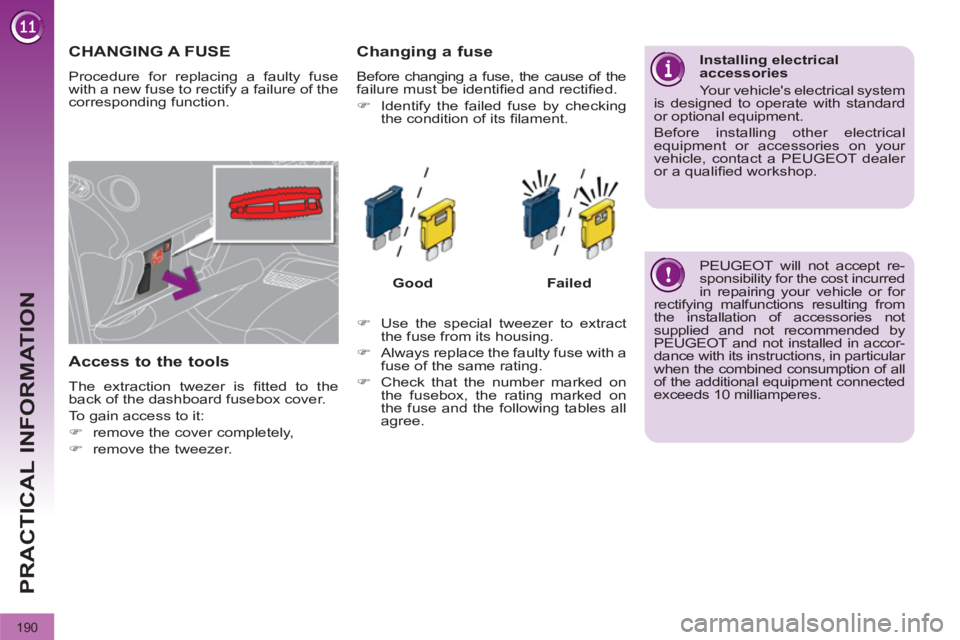
190
PRACTICAL INFORMATION
CHANGING A FUSE
Procedure for replacing a faulty fuse
with a new fuse to rectify a failure of the
corresponding function.
Access to the tools
The extraction twezer is fi tted to the
back of the dashboard fusebox cover.
To gain access to it:
�)
remove the cover completely,
�)
remove the tweezer.
Changing a fuse
Before changing a fuse, the cause of the
failure must be identifi ed and rectifi ed.
�)
Identify the failed fuse by checking
the condition of its fi lament.
Good
Failed
�)
Use the special tweezer to extract
the fuse from its housing.
�)
Always replace the faulty fuse with a
fuse of the same rating.
�)
Check that the number marked on
the fusebox, the rating marked on
the fuse and the following tables all
agree.
Installing electrical
accessories
Your vehicle's electrical system
is designed to operate with standard
or optional equipment.
Before installing other electrical
equipment or accessories on your
vehicle, contact a PEUGEOT dealer
or a qualifi ed workshop.
PEUGEOT will not accept re-
sponsibility for the cost incurred
in repairing your vehicle or for
rectifying malfunctions resulting from
the installation of accessories not
supplied and not recommended by
PEUGEOT and not installed in accor-
dance with its instructions, in particular
when the combined consumption of all
of the additional equipment connected
exceeds 10 milliamperes.
Page 193 of 328
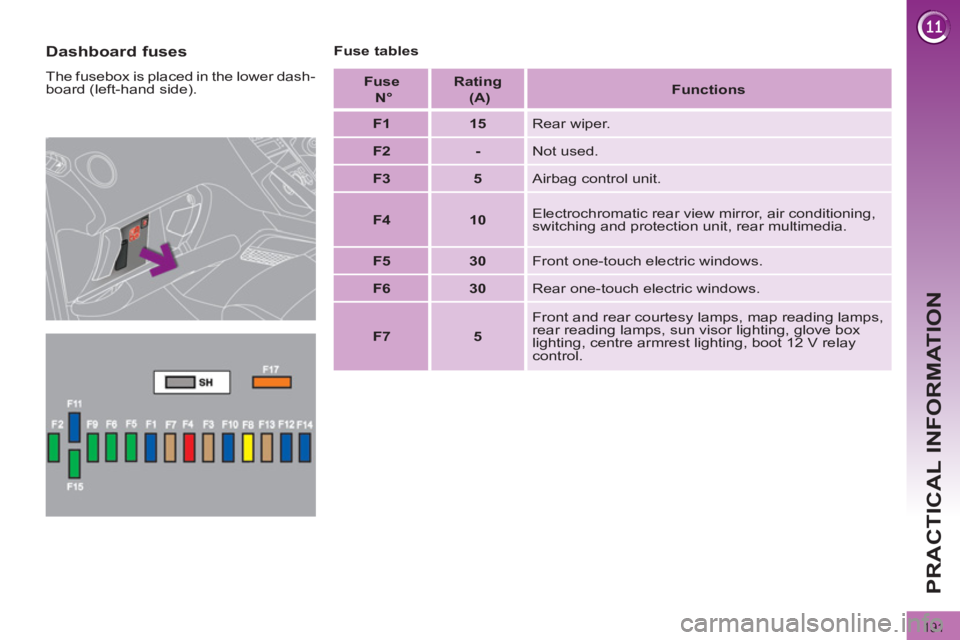
191
PRACTICAL INFORMATION
Dashboard fuses
The fusebox is placed in the lower dash-
board (left-hand side).
Fuse tables
Fuse
N°
Rating
(A)
Functions
F1
15
Rear wiper.
F2
-
Not used.
F3
5
Airbag control unit.
F4
10
Electrochromatic rear view mirror, air conditioning,
switching and protection unit, rear multimedia.
F5
30
Front one-touch electric windows.
F6
30
Rear one-touch electric windows.
F7
5
Front and rear courtesy lamps, map reading lamps,
rear reading lamps, sun visor lighting, glove box
lighting, centre armrest lighting, boot 12 V relay
control.
Page 318 of 328
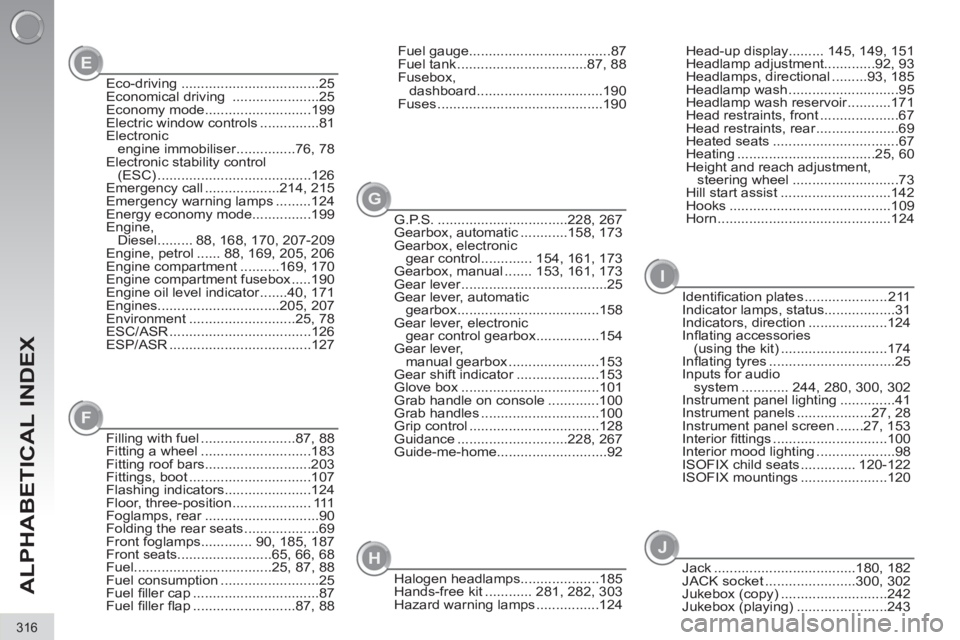
E
G
F
H
I
J
316
ALPHABETICAL INDEX
Eco-driving ...................................25
Economical driving ......................25
Economy mode...........................199
Electric window controls ...............81
Electronic
engine immobiliser ...............76, 78
Electronic stability control
(ESC) .......................................126
Emergency call ...................214, 215
Emergency warning lamps .........124
Energy economy mode...............199
Engine,
Diesel ......... 88, 168, 170, 207-209
Engine, petrol ...... 88, 169, 205, 206
Engine compartment ..........169, 170
Engine compartment fusebox .....190
Engine oil level indicator .......40, 171
Engines...............................205, 207
Environment ...........................25, 78
ESC/ASR ....................................126
ESP/ASR ....................................127G.P.S. .................................228, 267
Gearbox, automatic ............158, 173
Gearbox, electronic
gear control ............. 154, 161, 173
Gearbox, manual ....... 153, 161, 173
Gear lever .....................................25
Gear lever, automatic
gearbox ....................................158
Gear lever, electronic
gear control gearbox ................154
Gear lever,
manual gearbox .......................153
Gear shift indicator .....................153
Glove box ...................................101
Grab handle on console .............100
Grab handles ..............................100
Grip control .................................128
Guidance ............................228, 267
Guide-me-home............................92 Filling with fuel ........................87, 88
Fitting a wheel ............................183
Fitting roof bars...........................203
Fittings, boot ...............................107
Flashing indicators......................124
Floor, three-position .................... 111
Foglamps, rear .............................90
Folding the rear seats ...................69
Front foglamps............. 90, 185, 187
Front seats........................65, 66, 68
Fuel...................................25, 87, 88
Fuel consumption .........................25
Fuel fi ller cap ................................87
Fuel fi ller fl ap ..........................87, 88Fuel gauge....................................87
Fuel tank .................................87, 88
Fusebox,
dashboard ................................190
Fuses ..........................................190
Halogen headlamps....................185
Hands-free kit ............ 281, 282, 303
Hazard warning lamps ................124Head-up display......... 145, 149, 151
Headlamp adjustment.............92, 93
Headlamps, directional .........93, 185
Headlamp wash ............................95
Headlamp wash reservoir ...........171
Head restraints, front ....................67
Head restraints, rear .....................69
Heated seats ................................67
Heating ...................................25, 60
Height and reach adjustment,
steering wheel ...........................73
Hill start assist ............................142
Hooks .........................................109
Horn ............................................124
Identifi cation plates ..................... 211
Indicator lamps, status..................31
Indicators, direction ....................124
Infl ating accessories
(using the kit) ...........................174
Infl ating tyres ................................25
Inputs for audio
system ............ 244, 280, 300, 302
Instrument panel lighting ..............41
Instrument panels ...................27, 28
Instrument panel screen .......27, 153
Interior fi ttings .............................100
Interior mood lighting ....................98
ISOFIX child seats .............. 120-122
ISOFIX mountings ......................120
Jack ....................................180, 182
JACK socket .......................300, 302
Jukebox (copy) ...........................242
Jukebox (playing) .......................243
Page 324 of 328
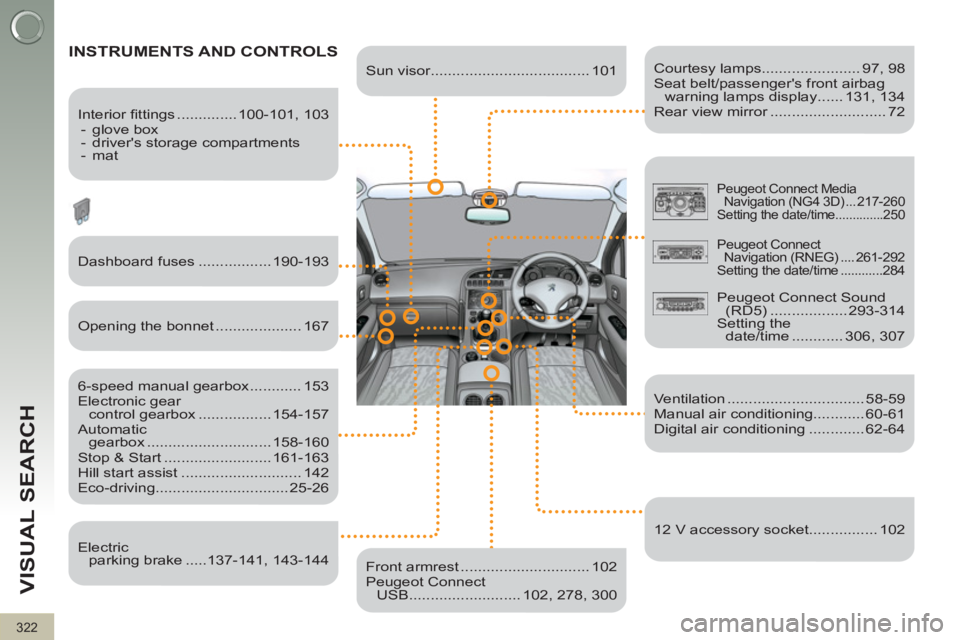
322
VISUAL SEARCH
INSTRUMENTS AND CONTROLS
Courtesy lamps....................... 97, 98
Seat belt/passenger's front airbag
warning lamps display ...... 131, 134
Rear view mirror ........................... 72
Dashboard fuses ................. 190-193
6-speed manual gearbox ............ 153
Electronic gear
control gearbox ................. 154-157
Automatic
gearbox ............................. 158-160
Stop & Start ......................... 161-163
Hill start assist ............................ 142
Eco-driving............................... 25-26
Ventilation ................................ 58-59
Manual air conditioning............ 60-61
Digital air conditioning ............. 62-64
Front armrest .............................. 102
Peugeot Connect
USB .......................... 102, 278, 300
Peugeot Connect Media
Navigation (NG4 3D) ... 217-260
Setting the date/time ..............250
Sun visor..................................... 101
Opening the bonnet .................... 167
Electric
parking brake .....137-141, 143-144
Interior fi ttings .............. 100-101, 103
- glove box
- driver's storage compartments
- mat
12 V accessory socket................ 102
Peugeot Connect
Navigation (RNEG) .... 261-292
Setting the date/time ............284
Peugeot Connect Sound
(RD5) .................. 293-314
Setting the
date/time ............ 306, 307